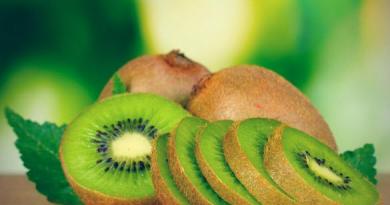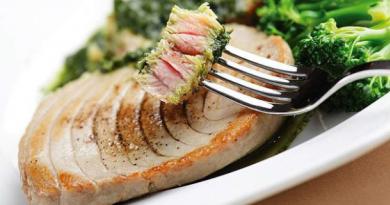Sea flounder (lat. Pleuronectes platessa) is a fish belonging to the corresponding family - Flatfish. The sea flounder lives in the seas of the Pacific (Okhotsk), Arctic (White) and Atlantic (Barents, Northern, Mediterranean, Black) oceans. Often enters the tidal zone of river mouths and lagoons. Serves as an object of trade and amateur fishing.
Description of flounder
Those who have seen a flounder at least once in their life will never confuse it with another fish. It is distinguished by a very strongly flattened body and the location of both eyes on the same side of the body. By the way, that side of the flounder that faces the bottom is not at all its belly. It turns out that the flounder swims "on its side". This is also evidenced by the fact that the flounder fry swim like all "normal fish" - along the longitudinal axis their body is located perpendicular to the bottom surface, and the eyes are on each side of the body, and only when the flounder matures "lays on its side", and one of its eyes shifts to the other side. Moreover, the eyes can shift both to the right side (in most individuals) and to the left.
Apparently, the evolution of the development of this species of fish contributed to its becoming less noticeable to predators, besides, the flat position of the body allows it to hunt from ambush: the flounder easily changes its color, almost completely merging with the bottom (mimicry). This mechanism is enhanced by the fact that it is able to burrow into sand or silt, leaving only eyes on the surface. And here it is impossible not to mention one more feature of the flounder: its eyes can separately look both forward and backward at the same time.
Flounder is a medium-sized fish. Reaches a length of 50-60 cm with a weight of up to 7 kg. However, most adults are 25-40 cm long and weigh up to 1.5 kg.
The blind, that is, facing the bottom, side is white with dark spots, and feels like fine sandpaper to the touch. The upper side is dark brown with rusty-brown spots.
flounder lifestyle
The sea flounder leads a bottom lifestyle at depths of up to 200 m, and in warmer seas - the Mediterranean and Black - up to 400 m.
It feeds on small mollusks, crabs, shrimps and other invertebrates.
It is distinguished by very high fecundity: one female can lay up to half a million eggs per season, most of which are eaten by other fish. During spawning, they can swim up to 30 km per day. Spawns in the intertidal zone.
How to choose and store flounder
When choosing flounder, preference should be given to fresh, not frozen, fish.
The first thing you should pay attention to when buying flounder is its smell. Fresh flounder has a specific smell, somewhat reminiscent of the smell of iodine, but in no case should it smell like rotten meat.
Secondly, if the fish is not frozen, lightly press on its side with your finger. If the dent formed from pressure quickly levels out, then you have a suitable product.
Finally, for any fish, a reliable indicator is the color of the gills. The flounder is no exception to this rule. Fresh fish have pink, scarlet or bright red gills. If they are dark gray, and even with green or bluish mucus, then the fish has been stored for a long time.
After buying flounder, it is best to cook and eat immediately. But if it needs to be preserved, then an ice-filled dish is best for this, in which you need to place the fish, and fill it with another portion of ice on top. In this form, it will lie on the bottom shelf of the refrigerator for 1-2 days. Frozen flounder can be stored for up to 4 months.
Cooking flounder
Flounder meat is highly valued for its tenderness and juiciness, which is why it is a regular in many fish markets and shops. For the economy of some countries, flounder is a significant source of budget revenues.
Despite the tenderness and juiciness of meat, not all people like flounder, because in the process of cooking it acquires a peculiar smell, somewhat reminiscent of the smell of a pharmacy. However, getting rid of it is quite simple: while cleaning the fish, you need to remove the skin from it. True, at the same time, as they say, you can throw out the child along with the water, sorry, along with the skin the most useful substances are Omega-3 (fatty acids), the benefits of which will be discussed below. Therefore, for especially fastidious family members, part of the flounder can be cooked separately.
Not all housewives know how to properly clean a flounder. And you need to do this as follows: first, from the blind side of the fish, you need to clean off the scales, then cut off the head, remove the insides and rinse the fish with water. Finally, cut off the fins and tail with a sharp knife (you can leave them for lovers of any crispy crusts), take dark skin from the side of the tail and pull it off with a sharp movement. However, the expediency of the last manipulation due to the presence of useful substances in it has just been said.
You can cook various dishes from flounder. It can be stewed, boiled, baked, fried, stuffed. But the ear from it, all because of the same smell, it turns out "for an amateur."
Flounder goes well with various vegetables (cucumbers, tomatoes, peppers, etc.), seafood (squid and shrimps), cereals (rice, buckwheat), pasta, sauces and seasonings.
You also need to fry the flounder correctly: at the beginning of frying, it is placed on a heated pan with the dark side - this way it will turn out more juicy and tender.

Nutritional value of flounder (per 100 g)
| Calorie content, kcal | 88-117 |
| Proteins, g | 17,5 |
| Fats, g, including: | 2 |
| Saturated fatty acids, g | 0,363 |
| Polyunsaturated fatty acids, g | 0,55 |
| Cholesterol, mg | 63 |
| Water, g | 79,9 |
| Ash, g | 1,1 |
| Macronutrients | |
| Potassium, mg | 311 |
| Calcium, mg | 61 |
| Magnesium, mg | 22 |
| Sodium, mg | 104 |
| Phosphorus, mg | 198 |
| Chlorine, mg | 165 |
| Sulfur, mg | 175 |
| trace elements | |
| Iron, mg | 0,9 |
| Zinc, mg | 0,7 |
| Manganese, mcg | 20 |
| Selenium, mcg | 33 |
| Iodine, mcg | 53 |
| Fluorine, mcg | 430 |
| Molybdenum, mcg | 4 |
| Nickel, mcg | 6 |
| vitamins | |
| Vitamin A (retinol), mcg | 13 |
| Vitamin B1 (thiamine), mcg | 210 |
| Vitamin B2 (riboflavin), mcg | 220 |
| Vitamin B 5 (pantothenic acid), mcg | 580 |
| Vitamin B 6 (pyridoxine), mcg | 240 |
| Vitamin B 9 (folic acid), mcg | 9 |
| Vitamin B 12 (cobalamins), mcg | 2,51 |
| Vitamin C (ascorbic acid), mg | 1,5 |
| Vitamin E (tocopherol), mg | 0,66 |
| Vitamin K (phylloquinone), mcg | 0,1 |
| Vitamin PP (niacin equivalent), mg | 2,9 |
| Choline, mg | 81 |
The benefits of flounder
From the point of view of proper nutrition, flounder is one of the most useful fish. It can rightly be considered a dietary product, because its calorie content is very low. Moreover, it is so rich in mineral elements, its protein is so well balanced in amino acid composition that even a small portion of this fish will muffle the feeling of hunger for a long time. For those who want to lose weight, I would recommend the real "flounder" diet. But this is not all the advantages of this unusual fish.
Flounder contains a huge amount of Omega-3 (fatty acids), which prevent the formation of atherosclerotic plaques on the walls of blood vessels and thereby serve to prevent atherosclerosis; remove excess cholesterol from the body, relieve inflammation in the vessels. If a person is sick with thrombophlebitis, varicose veins and even hemorrhoids, then flounder is categorically shown to him. Recent studies by scientists have found that these very Omega-3 acids kill cancer cells.
Sea flounder is one of the few fish that contains substances that enhance sexual desire (aphrodisiacs).
Sea flounder contains a lot of iodine, therefore it helps with many thyroid diseases. True, the main thing here is to know the measure, since with the hyperfunction of the latter, you can get the exact opposite effect.
There is a lot of potassium in flounder, which removes excess fluid from the body. Hence, a number of indications for the use of flounder: hypertension, edema, including cardiac origin, kidney and liver diseases.
The advantages of flounder can be listed for quite some time. This is a high content of B vitamins, the spectrum of therapeutic action of which is very wide, as well as iron, zinc, fluorine, etc. In general, systematically eat flounder, and many diseases will bypass you.
Harm of flounder
For a healthy person, flounder is absolutely harmless. You should not press on it only with hyperfunction of the thyroid gland, because, as just noted, it contains a lot of iodine.
Well. of course, do not forget about individual intolerance to any product and the possibility of an allergic reaction in this regard.
Fish: D-K
| Ruff | |||||||||



